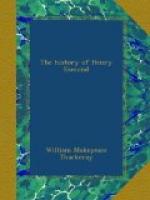Mr. Esmond dabbled in letters, and wrote a deal of prose and verse at this time of leisure. When displeased with the conduct of Miss Beatrix, he would compose a satire, in which he relieved his mind. When smarting under the faithlessness of women, he dashed off a copy of verses, in which he held the whole sex up to scorn. One day, in one of these moods, he made a little joke, in which (swearing him to secrecy) he got his friend Dick Steele to help him; and, composing a paper, he had it printed exactly like Steele’s paper, and by his printer, and laid on his mistress’s breakfast-table the following—
“Spectator.
“No. 341. “Tuesday, April 1, 1712.
Mutato nomine de te
Fabula narratur.—Horace.
Thyself the morain of
the fable see.—Creech.
“Jocasta is known as a woman of learning and fashion, and as one of the most amiable persons of this court and country. She is at home two mornings of the week, and all the wits and a few of the beauties of London flock to her assemblies. When she goes abroad to Tunbridge or the Bath, a retinue of adorers rides the journey with her; and besides the London beaux, she has a crowd of admirers at the Wells, the polite amongst the natives of Sussex and Somerset pressing round her tea-tables, and being anxious for a nod from her chair. Jocasta’s acquaintance is thus very numerous. Indeed, ’tis one smart writer’s work to keep her visiting-book—a strong footman is engaged to carry it; and it would require a much stronger head even than Jocasta’s own to remember the names of all her dear friends.
“Either at Epsom Wells or at Tunbridge (for of this important matter Jocasta cannot be certain) it was her ladyship’s fortune to become acquainted with a young gentleman, whose conversation was so sprightly, and manners amiable, that she invited the agreeable young spark to visit her if ever he came to London, where her house in Spring Garden should be open to him. Charming as he was, and without any manner of doubt a pretty fellow, Jocasta hath such a regiment of the like continually marching round her standard, that ’tis no wonder her attention is distracted amongst them. And so, though this gentleman made a considerable impression upon her, and touched her heart for at least three-and-twenty minutes, it must be owned that she has forgotten his name. He is a dark man, and may be eight-and-twenty years old. His dress is sober, though of rich materials. He has a mole on his forehead over his left eye; has a blue ribbon to his cane and sword, and wears his own hair.
“Jocasta was much flattered by beholding her admirer (for that everybody admires who sees her is a point which she never can for a moment doubt) in the next pew to her at St. James’s Church last Sunday; and the manner in which he appeared to go to sleep during the sermon—though from under his fringed eyelids it was evident he was casting glances of respectful rapture towards Jocasta—deeply moved and interested her. On coming out of church, he found his way to her chair, and made her an elegant bow as she stepped into it. She saw him at Court afterwards, where he carried himself with a most distinguished air, though none of her acquaintances knew his name; and the next night he was at the play, where her ladyship was pleased to acknowledge him from the side-box.




